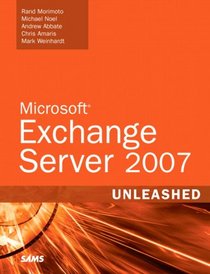Search -
Microsoft Exchange Server 2007 Unleashed
Microsoft Exchange Server 2007 Unleashed
Author:
This is the ultimate guide to the design, migration, implementation, administration, management, and support of an Exchange Server 2007 environment. The recommendations, tips, and tricks covered are based on more than two years of early adopter implementations of Exchange 2007. The authors highlight the features and functions that organizations ... more »
Author:
This is the ultimate guide to the design, migration, implementation, administration, management, and support of an Exchange Server 2007 environment. The recommendations, tips, and tricks covered are based on more than two years of early adopter implementations of Exchange 2007. The authors highlight the features and functions that organizations ... more »
ISBN-13: 9780672329203
ISBN-10: 0672329204
Publication Date: 1/23/2007
Pages: 1,344
Edition: 1
Rating: ?
ISBN-10: 0672329204
Publication Date: 1/23/2007
Pages: 1,344
Edition: 1
Rating: ?
0 stars, based on 0 rating
Genres:
- Computers & Technology >> Web Development & Design >> Internet Applications >> Email
- Computers & Technology >> Networking & Cloud Computing >> Data in the Enterprise >> Client-Server Systems
- Computers & Technology >> Software >> Business >> General
- Computers & Technology >> Software >> Groupware & Communications >> E-mail
- Computers & Technology >> Internet & Social Media >> Networking
- Computers & Technology >> Operating Systems >> Windows >> Windows Desktop >> Windows - General
- Computers & Technology >> Programming >> Microsoft Programming >> Exchange
- Computers & Technology >> Hardware & DIY >> General
- Computers & Technology >> General




